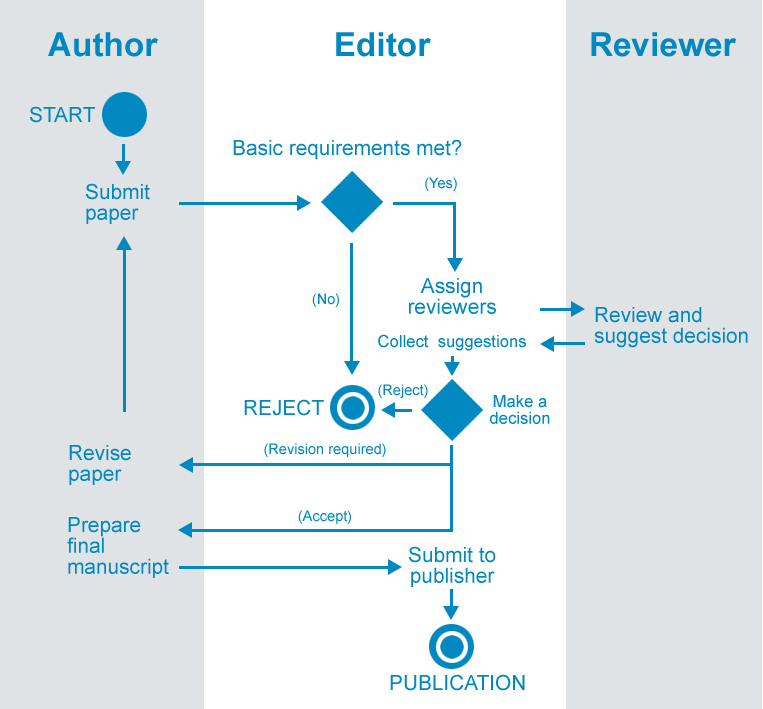
Once you have chosen where to publish, you must prepare your manuscript according to the requirements of the publisher. You may publish your research in books, journals or conference proceedings. This page guides you through the process of preparing a manuscript for submission to a peer-reviewed journal, including
- instructions to authors
- submission of the manuscript
- the peer-review process
- pre-print and publication
In the Review and Write module, you will find a more information on academic writing in general, and how to structure your manuscript.
Instructions to authors
A key point when publishing in journals is to familiarise yourself with the formal requirements for manuscript submission. These requirements are found in the author guidelines, or instructions to authors, commonly found on the journal's website.
The formal requirements include both content and layout, in addition to the technical requirements for submitting a manuscript. You will also find information about the journal's open access policy. Your funding source or employer may have specific regulations on open access. You need to consider co-authorship and copyright to ensure your rights as an author are not violated. You will also need to address any conflicts of interest concerning the work you are publishing. When your manuscript has been accepted for publication, you will sign a contract confirming the copyright issues of the publication.
Most publishers require that the article has not been submitted elsewhere.
Submission
Cover letter: When submitting a manuscript to a journal, it is common to include a cover letter to the editor. The letter contains information about your submission. Common points to address are:
- Are you publishing several works from the same material? Or have parts of the work been published previously?
- Are there any conflicts of interest?
- If you have co-authors, have all of them had the opportunity to read and approve the manuscript?
- As a corresponding author, you will need to give your name and the address of your institution.
Manuscript file: The requirements for the file format, including text, figures and tables, will vary between journals and editors. You must pay attention to such details as page numbers and double spacing. Some journals have different formatting rules for different types of article. Most journals have a web-based, electronic submission system.
Response to peer reviewers: If the manuscript is a re-submission after revisions, the response should be formulated according to the instructions to authors.
Accessibility to the data: Sometimes it is essential for readers to have access to the data behind an article. There are several options as to how and where to store the data in order to make them accessible. Certain research domains have large data archives, and you will be expected to deposit your data there. The journal itself may provide storage space for the data as a supplement to the article, or your institution may provide a service for data archives.
Publishing contract: For each accepted submission, you will sign a contract with the publisher. Each publisher has its own specific regulations on issues of copyright, reuse and accessibility. Important matters to consider before signing a publishing contract are
- copyright and ownership of the work
- self-archiving
- open access or subscription-based access
You will also need to make sure the contract does not violate any terms your employer or research funder has stipulated for publishing your research.
The peer-review process
Manuscript would need to be revised to comply with the requirements of our journal. (Letter from an editor)
A manuscript submitted to a peer-reviewed journal will be sent to a number of referees chosen by the journal editors. These referees are researchers working in the general field of the journal, and are often experts in the specific field that the manuscript covers. The referees and editors will screen the manuscript and ask questions such as:
- Does the study have an original scholarly or scientific message?
- Do the message, content and topic fit the scope of the journal?
- Does the work make a useful and interesting contribution to the research field?
- Is the work focused and presented in a logical manner, so that the reader will understand the authors’ conclusions?
- Is the language clear?
- Does the manuscript follow the journal’s instructions to authors?
The outcome of the peer review may be
Unsuitable for our readership. (Letter from an editor)
- acceptance of the manuscript without revisions
- acceptance with minor or major revisions
- rejection of the manuscript
The referees will often provide new views on the work, with suggestions for further improvement of the manuscript. Use these comments to improve the manuscript for any re-submission. If your manuscript is rejected, be even more stringent in choosing another journal to submit to, since choosing a journal which requires a totally different structure and layout will entail additional work. Once your manuscript has been accepted for publication, you will receive a manuscript proof that you have to read carefully, to check that there are no printing or layout errors.

Pre-print and publication
Some journals offer a pre-print publication possibility, where your full-text article is published on the journal website prior to the final version. Traditionally, publishers have discouraged publication of pre-prints. However, the increasing use of online pre-print archives such as arXiv.org (an archive for electronic pre-prints of scientific papers mainly in mathematics, physics and astronomy) has led to an increase in acceptance and encouragement for such pre-print and self-archive practices. Discussions and reviews of manuscripts in pre-print have added an extra level to the peer-review process, as more revised versions of a manuscript are now openly available.
References
Derntl, M. (2014). Basics of research paper writing and publishing. International Journal of Technology Enhanced Learning, 6(2), 105-123. https://doi.org/10.1504/IJTEL.2014.066856





